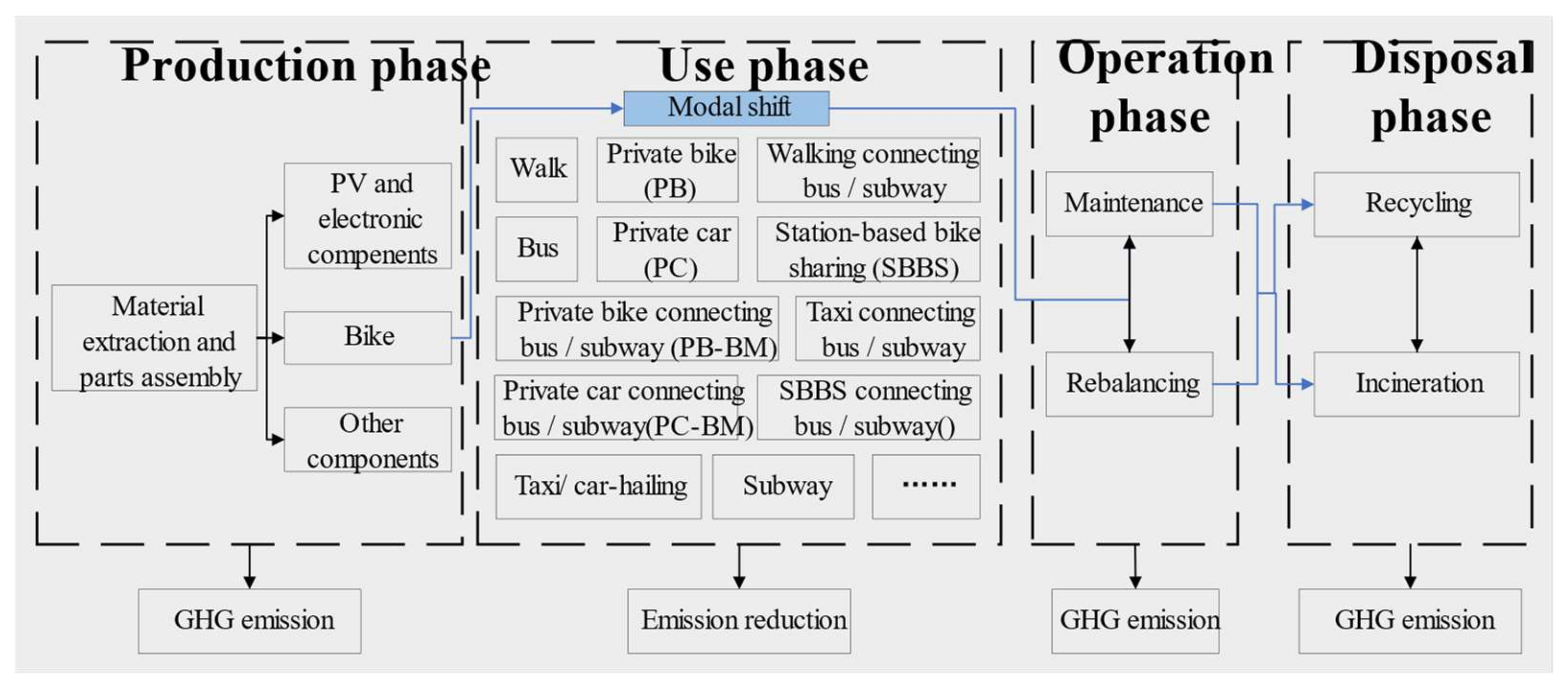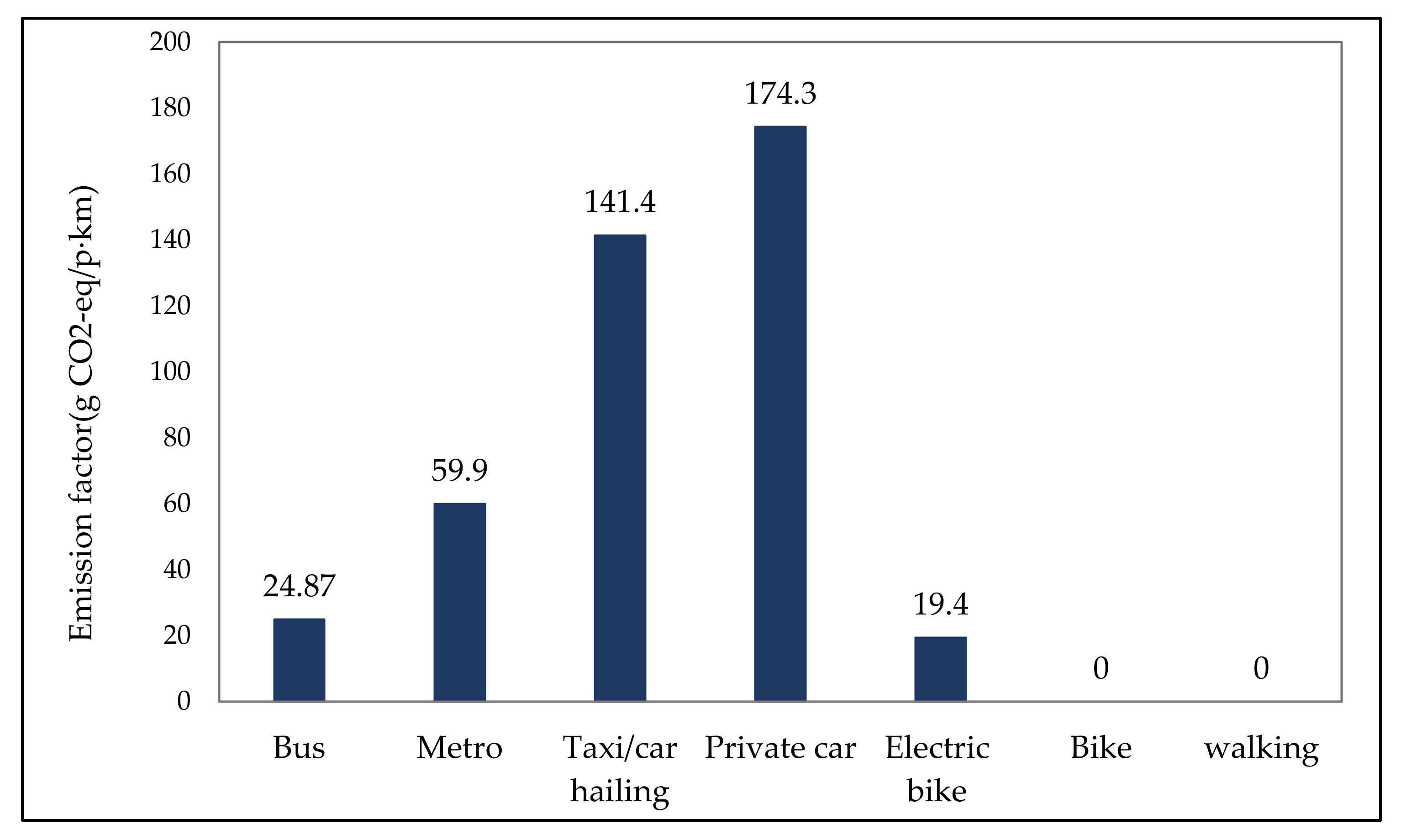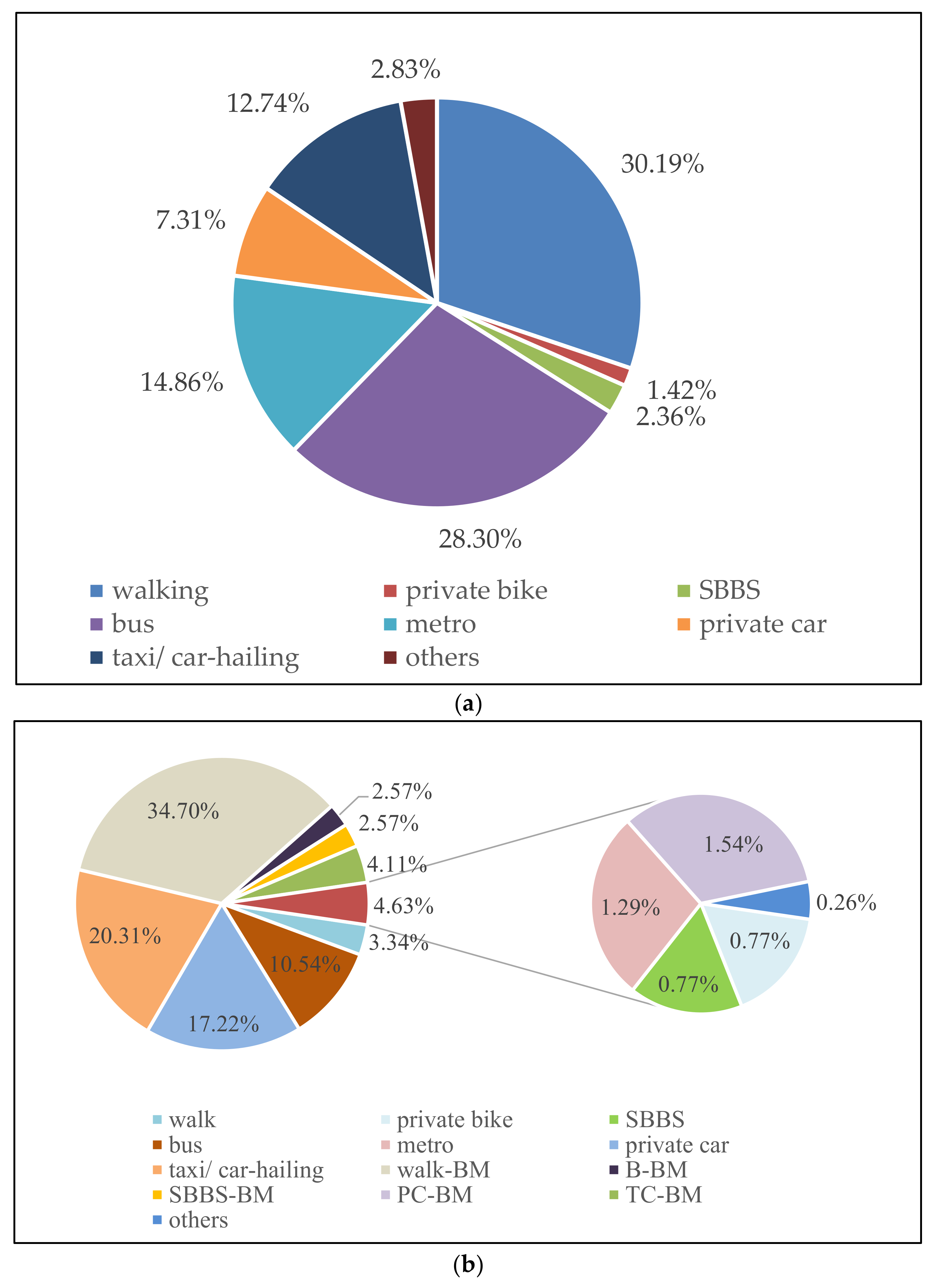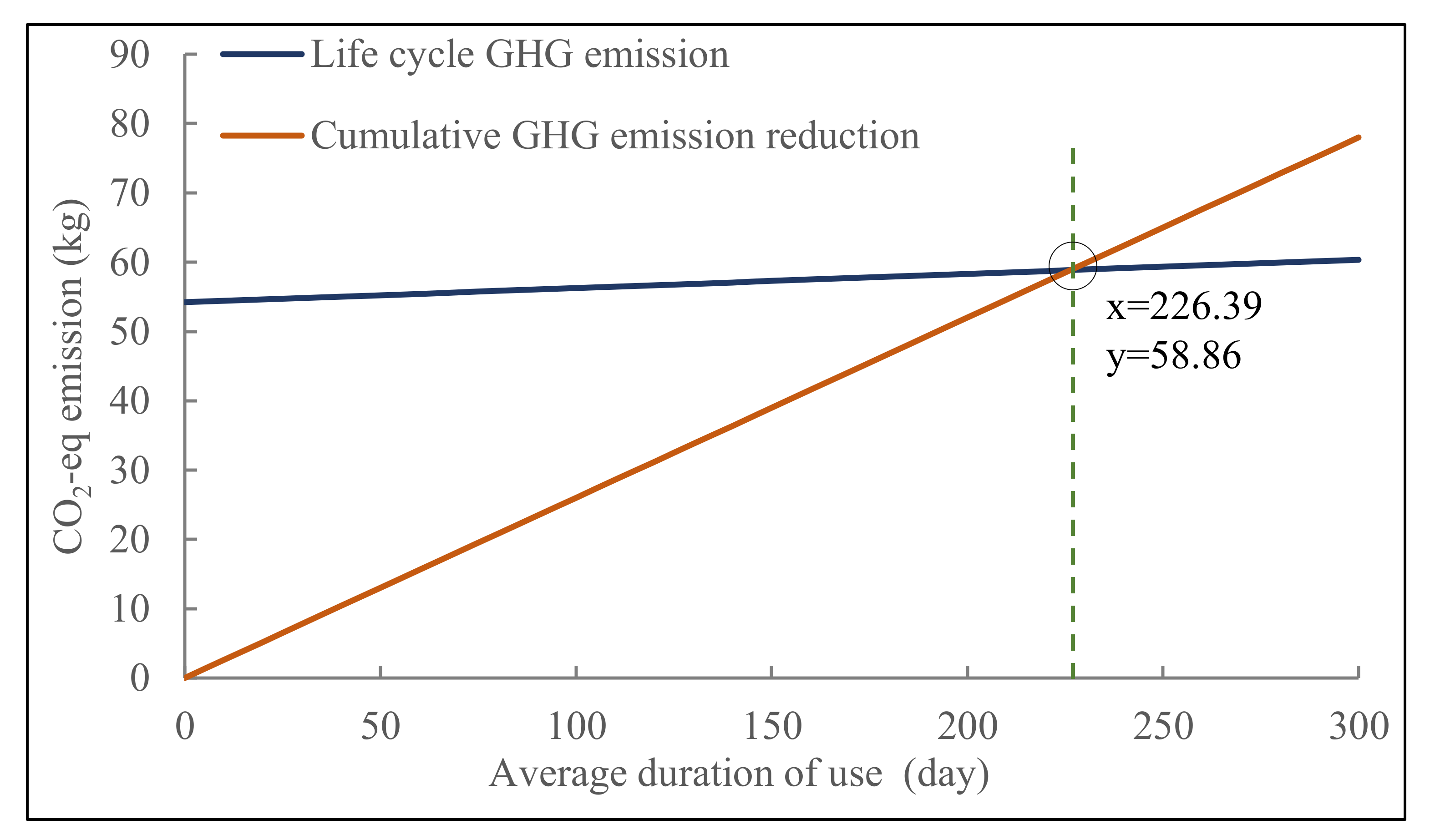Life Cycle Assessment of Free-Floating Bike Sharing on Greenhouse Gas Emissions: A Case Study in Nanjing, China
Abstract
:1. Introduction
- What are the modal shift patterns and environmental benefits of FFBS in different usage patterns?
- Do the environmental benefits of FFBS change throughout its life cycle when considering the trip chain?
2. Literature Review
3. Materials and Methods
3.1. Study Area
3.2. Questionnaire
3.3. Method
3.3.1. The Environmental Impact Calculations
- is the GHG emission generated by FFBS;
- is the average trip distance (km) of a FFBS trip;
- is the average annual turnover number of FFBS;
- is the service life of FFBS (years);
- is the kth energy consumption required by FFBS; and
- is the GHG emission factor of the kth energy.
- is the GHG emission when the unit FFBS is transported to the destination;
- is the distance between the production place and the destination;
- is the energy consumption of the unit delivery truck used;
- is the GHG emission factor of the energy; and
- is the load FFBS number of per transportation truck available.
- is the emission of per FFBS during rebalancing;
- is the total number of dispatched vehicles in Nanjing;
- is the proportion of the rth dispatched vehicles;
- is the GHG emission factor of the rth dispatched vehicles in use phase;
- is the average daily rebalancing distance per rth dispatched vehicles; and
- is the total number of FFBS in Nanjing.
3.3.2. Respondents Weighted Factor
3.3.3. Generalization of the Sample to the Nanjing Usages
4. Results
4.1. Descriptive Analysis
4.2. GHG Emission Reduction Results
4.2.1. Substitute Structures
4.2.2. The Total GHG Emission of FFBS in Life Cycle
4.2.3. Assessing the GHG Emission Reduction of Every FFBS Trip
5. Conclusions
- Through the questionnaire survey, it was found that the average riding distance of users was different under different usage patterns. The average riding distance was 2.3 km of using FFBS directly for short-distance trips. The average riding distance for users using FFBS to connect to public transport was 1.9 km. In addition, in the samples for Pattern 2, the frequency of respondents using FFBS was higher than that of respondents of Pattern 1. The complementary role of FFBS and public transport enhances the accessibility of both sides and provides users with a more convenient and efficient trip mode.
- FFBS is not a zero-carbon transport tool. In its life cycle, GHG emissions will be generated in the production, operation, and disposal phases. A total of 76.710 kg CO2-eq emissions are generated for each FFBS. The production phase will generate the most CO2 emissions, accounting for 70.67%. The environmental effect of FFBS is mainly achieved by replacing other high-emission transport modes in the use phase. In the sample of Pattern 1, nearly 80% chose other non-motorized modes or public transport modes as alternatives. In the sample of Pattern 2, 43.20% chose motorized traffic as alternatives.
- When Nanjing has 257,000 FBBS and each FFBS is used on average once a day, the break-even point is about 227 days, which means the FFBS system can achieve a positive net environmental benefit. The amount of FFBS environmental benefits mainly depends on the modal shift and its use efficiency. When the turnover rate becomes higher, the environmental benefit will also be significantly improved.
Author Contributions
Funding
Institutional Review Board Statement
Informed Consent Statement
Data Availability Statement
Conflicts of Interest
References
- Yuan, Z.Y.; Li, Z.Y.; Kang, L.P.; Tan, X.Y.; Zhou, X.J.; Li, X.J.; Li, C.; Peng, T.D.; Ou, X.M. A review of low-carbon measurements and transition pathway of transport sector in China. Clim. Change Res. 2021, 17, 27–35. [Google Scholar] [CrossRef]
- Wang, H.L.; He, J.K. Peaking rule of CO2 emissions, energy consumption and transport volume in transportation sector. China Popul. Resour. Environ. 2018, 28, 59–65. [Google Scholar] [CrossRef]
- Patrão, C.; Moura, P.; Almeida, A.T.d. Review of Smart City Assessment Tools. Smart Cities 2020, 3, 55. [Google Scholar] [CrossRef]
- Martins, F.; Patrão, C.; Moura, P.; de Almeida, A.T. A Review of Energy Modeling Tools for Energy Efficiency in Smart Cities. Smart Cities 2021, 4, 75. [Google Scholar] [CrossRef]
- Bibri, S.E.; Krogstie, J. Smart sustainable cities of the future: An extensive interdisciplinary literature review. Sustain. Cities Soc. 2017, 31, 183–212. [Google Scholar] [CrossRef]
- Shiroishi, Y.; Uchiyama, K.; Suzuki, N. Society 5.0: For Human Security and Well-Being. Computer 2018, 51, 91–95. [Google Scholar] [CrossRef]
- Olariu, S. A Survey of Vehicular Cloud Research: Trends, Applications and Challenges. IEEE Trans. Intell. Transp. Syst. 2020, 21, 2648–2663. [Google Scholar] [CrossRef]
- Chourabi, H.; Nam, T.; Walker, S.; Gil-Garcia, J.R.; Mellouli, S.; Nahon, K.; Pardo, T.A.; Scholl, H.J. Understanding Smart Cities: An Integrative Framework. In Proceedings of the 2012 45th Hawaii International Conference on System Sciences, Maui, HI, USA, 4–7 January 2012; pp. 2289–2297. [Google Scholar]
- Olariu, S.; Popescu, D.C. SEE-TREND: SEcurE Traffic-Related EveNt Detection in Smart Communities. Sensors 2021, 21, 7652. [Google Scholar] [CrossRef]
- Moradbeikie, A.; Keshavarz, A.; Rostami, H.; Paiva, S.; Lopes, S.I. GNSS-Free Outdoor Localization Techniques for Resource-Constrained IoT Architectures: A Literature Review. Appl. Sci. 2021, 11, 793. [Google Scholar] [CrossRef]
- Ligarski, M.J.; Wolny, M. Quality of Life Surveys as a Method of Obtaining Data for Sustainable City Development—Results of Empirical Research. Energies 2021, 14, 7592. [Google Scholar] [CrossRef]
- Cerutti, P.S.; Martins, R.D.; Macke, J.; Sarate, J.A.R. “Green, but not as green as that”: An analysis of a Brazilian bike-sharing system. J. Clean. Prod. 2019, 217, 185–193. [Google Scholar] [CrossRef]
- Nam, T.; Pardo, T.A. Conceptualizing smart city with dimensions of technology, people, and institutions. In Proceedings of the 12th Annual International Digital Government Research Conference: Digital Government Innovation in Challenging Times, College Park, MD, USA, 12–15 June 2011; pp. 282–291. [Google Scholar]
- Arena, M.; Cheli, F.; Zaninelli, D.; Capasso, A.; Lamedica, R.; Piccolo, A. Smart Mobility for Sustainability. In Proceedings of the AEIT Annual Conference 2013, Palermo, Italy, 3–5 October 2013; pp. 1–6. [Google Scholar]
- Mi, Z.; Coffman, D.M. The sharing economy promotes sustainable societies. Nat. Commun. 2019, 10, 1214. [Google Scholar] [CrossRef] [PubMed] [Green Version]
- Enochsson, L.; Voytenko Palgan, Y.; Plepys, A.; Mont, O. Impacts of the Sharing Economy on Urban Sustainability: The Perceptions of Municipal Governments and Sharing Organisations. Sustainability 2021, 13, 4213. [Google Scholar] [CrossRef]
- Shaheen, S.A.; Guzman, S.; Zhang, H. Bikesharing in Europe, the Americas, and Asia:Past, Present, and Future. Transp. Res. Rec. 2010, 2143, 159–167. [Google Scholar] [CrossRef] [Green Version]
- Ma, X.; Ji, Y.; Yuan, Y.; Van Oort, N.; Jin, Y.; Hoogendoorn, S. A comparison in travel patterns and determinants of user demand between docked and dockless bike-sharing systems using multi-sourced data. Transp. Res. Part A Policy Pract. 2020, 139, 148–173. [Google Scholar] [CrossRef]
- Luo, H.; Kou, Z.; Zhao, F.; Cai, H. Comparative life cycle assessment of station-based and dock-less bike sharing systems. Resour. Conserv. Recycl. 2019, 146, 180–189. [Google Scholar] [CrossRef]
- Ji, Y.; Ma, X.; He, M.; Jin, Y.; Yuan, Y. Comparison of usage regularity and its determinants between docked and dockless bike-sharing systems: A case study in Nanjing, China. J. Clean. Prod. 2020, 255, 120110. [Google Scholar] [CrossRef]
- Risimati, B.; Gumbo, T.; Chakwizira, J. Spatial Integration of Non-Motorized Transport and Urban Public Transport Infrastructure: A Case of Johannesburg. Sustainability 2021, 13, 1461. [Google Scholar] [CrossRef]
- Boulange, C.; Gunn, L.; Giles-Corti, B.; Mavoa, S.; Pettit, C.; Badland, H. Examining associations between urban design attributes and transport mode choice for walking, cycling, public transport and private motor vehicle trips. J. Transp. Health 2017, 6, 155–166. [Google Scholar] [CrossRef]
- Arroub, A.; Zahi, B.; Sabir, E.; Sadik, M. A literature review on Smart Cities: Paradigms, opportunities and open problems. In Proceedings of the 2016 International Conference on Wireless Networks and Mobile Communications (WINCOM), Fez, Morocco, 26–29 October 2016; pp. 180–186. [Google Scholar]
- Luo, H.; Zhao, F.; Chen, W.-Q.; Cai, H. Optimizing bike sharing systems from the life cycle greenhouse gas emissions perspective. Transp. Res. Part C Emerg. Technol. 2020, 117, 102705. [Google Scholar] [CrossRef]
- Chenyan, Z. Research on the coopetition relationship between Public bus and Bike sharing and policy effect: Based on travel mode choice. Master’s Thesis, Beijing Jiaotong University, Beijing, China, 2020. [Google Scholar]
- Ma, L.; Zhang, X.; Ding, X.; Wang, G. Bike sharing and users’ subjective well-being: An empirical study in China. Transp. Res. Part A Policy Pract. 2018, 118, 14–24. [Google Scholar] [CrossRef]
- De Chardon, C.M. The contradictions of bike-share benefits, purposes and outcomes. Transp. Res. Part A Policy Pract. 2019, 121, 401–419. [Google Scholar] [CrossRef]
- United Nations. United Nations Sustainable Development Goals. Available online: https://www.un.org/sustainabledevelopment/ (accessed on 19 November 2021).
- Jie, W. Study on the Influence of Bike-sharing on Carbon Emissions in Traffic Field and its Policy Implications. Master’s Thesis, Beijing University of Civil Engineering and Architecture, Beijing, China, 2019. [Google Scholar]
- Zhang, Y.; Mi, Z. Environmental benefits of bike sharing: A big data-based analysis. Appl. Energy 2018, 220, 296–301. [Google Scholar] [CrossRef]
- Anderson, N.A. Portland Bicycle Share Health Impact Assessment. 2015. Available online: https://digitalcommons.usm.maine.edu/cgi/viewcontent.cgi?article=1108&context=muskie_capstones (accessed on 5 May 2021).
- Shaheen, S.; Martin, E.; Cohen, A. Public Bikesharing and Modal Shift Behavior: A Comparative Study of Early Bikesharing Systems in North America. Int. J. Transp. 2013, 1, 35–54. [Google Scholar] [CrossRef]
- Fan, A.; Chen, X.; Wan, T. How Have Travelers Changed Mode Choices for First/Last Mile Trips after the Introduction of Bicycle-Sharing Systems: An Empirical Study in Beijing, China. J. Adv. Transp. 2019, 2019, 5426080. [Google Scholar] [CrossRef] [Green Version]
- Li, P.; Zhao, P.; Brand, C. Future energy use and CO2 emissions of urban passenger transport in China: A travel behavior and urban form based approach. Appl. Energy 2018, 211, 820–842. [Google Scholar] [CrossRef]
- Rose, E.; Gallivan, F.; Lara, L. Survey-Based Evaluation of Bike-to-Work Day in the San Francisco Bay Area. In Proceedings of the Transportation Research Board 95th Annual Meeting, Washington, DC, USA, 10–14 January 2016. [Google Scholar]
- Wang, Z.; Xue, M.; Zhao, Y.; Zhang, B. Trade-off between environmental benefits and time costs for public bicycles: An empirical analysis using streaming data in China. Sci. Total Environ. 2020, 715, 136847. [Google Scholar] [CrossRef]
- Kou, Z.; Wang, X.; Chiu, S.F.; Cai, H. Quantifying greenhouse gas emissions reduction from bike share systems: A model considering real-world trips and transportation mode choice patterns. Resour. Conserv. Recycl. 2020, 153, 104534. [Google Scholar] [CrossRef]
- Bonilla-Alicea, R.; Watson, B.C.; Shen, Z.; Tamayo, L.; Telenko, C. Life cycle assessment to quantify the impact of technology improvements in bike: Haring systems. J. Ind. Ecol. 2020, 24, 138–148. [Google Scholar] [CrossRef] [Green Version]
- Zheng, F.; Gu, F.; Zhang, W.; Guo, J. Is Bicycle Sharing an Environmental Practice? Evidence from a Life Cycle Assessment Based on Behavioral Surveys. Sustainability 2019, 11, 1550. [Google Scholar] [CrossRef] [Green Version]
- Chen, J.; Zhou, D.; Zhao, Y.; Wu, B.; Wu, T. Life cycle carbon dioxide emissions of bike sharing in China: Production, operation, and recycling. Resour. Conserv. Recycl. 2020, 162, 105011. [Google Scholar] [CrossRef]
- Nanjing Transport Bureau. Report on Business Service Evaluation of Free-floating Bike Sharing Enterprises in the First Half of 2020. Available online: http://jtj.nanjing.gov.cn/njsjtysj/202012/t20201204_2742897.html (accessed on 30 June 2021).
- Nanjing Planning Bureau. Annual Report of Nanjing Traffic Development 2018; Nanjing Planning Bureau: Nanjing, China, 2018. [Google Scholar]
- Southeast University. Research on Development of Free-Floating Bike Sharing in Jiangsu Province; Southeast University: Nanjing, China, 2017. [Google Scholar]
- De Bortoli, A.; Christoforou, Z. Consequential LCA for territorial and multimodal transportation policies: Method and application to the free-floating e-scooter disruption in Paris. J. Clean. Prod. 2020, 273. [Google Scholar] [CrossRef]
- Niu, T. Development of High-Resolution Road Vehicle Emission Inventory for Nanjing Based on Intelligent Transportation Big Data. Master’s Thesis, Tsinghua University, Beijing, China, 2017. [Google Scholar]
- Liu, S. Quantitative Analysis of Social Benefits of Nanjing Metro Line 4. Logist. Enginering Manag. 2020, 42, 130–132. [Google Scholar] [CrossRef]
- Didi Development Research Institute, D.C. Didi Platform Green Transport White Paper 2020. 2020. Available online: https://figshare.com/articles/book/Didi_Platform_Green_Transport_White_Paper_2020_pdf/17056415 (accessed on 8 May 2021).
- Haupt, M.; Kägi, T.; Hellweg, S. Life cycle inventories of waste management processes. Data Brief 2018, 19, 1441–1457. [Google Scholar] [CrossRef]
- Park, C.; Sohn, S.Y. An optimization approach for the placement of bicycle-sharing stations to reduce short car trips: An application to the city of Seoul. Transp. Res. Part A Policy Pract. 2017, 105, 154–166. [Google Scholar] [CrossRef]
- Lin, J.R.; Yang, T.H. Strategic design of public bicycle sharing systems with service level constraints. Transp. Res. Part E Logist. Transp. Rev. 2011, 47, 284–294. [Google Scholar] [CrossRef]
- Braun, L.M.; Rodriguez, D.A.; Cole-Hunter, T.; Ambros, A.; Donaire-Gonzalez, D.; Jerrett, M.; Mendez, M.A.; Nieuwenhuijsen, M.J.; de Nazelle, A. Short-term planning and policy interventions to promote cycling in urban centers: Findings from a commute mode choice analysis in Barcelona, Spain. Transp. Res. Part A Policy Pract. 2016, 89, 164–183. [Google Scholar] [CrossRef] [Green Version]




| Small Truck | Iveco Vehicle | Three-Wheel Electric Vehicle | |
|---|---|---|---|
| Number of single-load | 50–60 | 20–25 | 10–15 |
| Daily average scheduling distance (km) | 80–120 | 60–80 | without limitation |
| Daily average scheduling times | 4–5 | 5–7 | 10 |
| FFES Usage Frequency Range | Annual Average Number of FFBS Ride | Explanation |
|---|---|---|
| Less than once a week | 15 | |
| Once a week | 52 | |
| Two to three times a week | 130 | 2.5 times a week, every week for the year |
| Four to five times a week | 234 | 4.5 times a week, every week for the year |
| More than 5 times a week | 312 | 6 times a week, multiplied by 52 weeks |
| Trip Purpose | Income Per Year | Personally Owned Means of Transport | |||
|---|---|---|---|---|---|
| Commuting trip | 34.20% | <80,000 | 63.44% | private bike | 29.48% |
| Leisure trip | 31.20% | 80,000–160,000 | 31.37% | electric bicycle | 61.08% |
| Return trip | 6.80% | >160,000 | 5.19% | private car | 57.78% |
| Elasticity trip | 27.80% | ||||
| Age | Use frequency per week | Cycling distance using free-floating bike sharing | |||
| 12–18 | 9.20% | Less than once | 56.84% | <1 km | 29.25% |
| 19–26 | 38.68% | Once | 14.15% | 1–2 km | 32.31% |
| 27–34 | 23.35% | Two to three times | 16.98% | 2–5 km | 31.37% |
| 34–44 | 19.10% | Four to five times | 6.84% | 5–10 km | 6.60% |
| 45–60 | 9.67% | More than 5 times | 5.19% | >10 km | 0.47% |
| >60 | 0.00% | ||||
| Trip Purpose | Income Per Year | Personally Owned Means of Transport | Mode of Transport Connected to FFBS | ||||
|---|---|---|---|---|---|---|---|
| Commuting trip | 49.90% | <80,000 | 49.10% | private bike | 40.36% | Bus | 25.45% |
| Leisure trip | 28.50% | 80,000–160,000 | 42.93% | electric bike | 69.92% | metro | 74.55% |
| Return trip | 8.70% | >160,000 | 7.97% | private car | 74.81% | ||
| Elasticity trip | 12.90% | ||||||
| Age | Use frequency per week | Cycling distance using free-floating bike sharing | Trip time using bus or metro | ||||
| 12–18 | 2.06% | Less than once | 29.82% | <1 km | 12.60% | <5 min | 2.06% |
| 19–26 | 45.76% | Once | 15.94% | 1–2 km | 60.41% | 5–10 min | 18.25% |
| 27–34 | 33.93% | 2 to 3 times | 35.22% | 2–5 km | 26.22% | 10–20 min | 33.42% |
| 34–44 | 13.88% | Four to five times | 10.03% | 5–10 km | 0.77% | 20–30 min | 26.99% |
| 45–60 | 4.11% | More than 5 times | 9.00% | >10 km | 0.00% | 30–40 min | 13.11% |
| >60 | 0.26% | 40–50 min | 4.11% | ||||
| 50–60 min | 1.54% | ||||||
| >60 min | 0.51% | ||||||
Publisher’s Note: MDPI stays neutral with regard to jurisdictional claims in published maps and institutional affiliations. |
© 2021 by the authors. Licensee MDPI, Basel, Switzerland. This article is an open access article distributed under the terms and conditions of the Creative Commons Attribution (CC BY) license (https://creativecommons.org/licenses/by/4.0/).
Share and Cite
Lai, R.; Ma, X.; Zhang, F.; Ji, Y. Life Cycle Assessment of Free-Floating Bike Sharing on Greenhouse Gas Emissions: A Case Study in Nanjing, China. Appl. Sci. 2021, 11, 11307. https://doi.org/10.3390/app112311307
Lai R, Ma X, Zhang F, Ji Y. Life Cycle Assessment of Free-Floating Bike Sharing on Greenhouse Gas Emissions: A Case Study in Nanjing, China. Applied Sciences. 2021; 11(23):11307. https://doi.org/10.3390/app112311307
Chicago/Turabian StyleLai, Ruxin, Xinwei Ma, Fan Zhang, and Yanjie Ji. 2021. "Life Cycle Assessment of Free-Floating Bike Sharing on Greenhouse Gas Emissions: A Case Study in Nanjing, China" Applied Sciences 11, no. 23: 11307. https://doi.org/10.3390/app112311307





